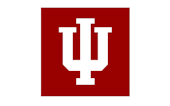I have been fortunate in my professional career to combine two areas that I love: broadcast news and university research/teaching. I started my journalism career right here at Indiana University, studying under legendary broadcast news professor Richard Yoakam. I worked as News Director at WIUS (now WIUX) radio as well reporting and producing for WFIU radio during my college years.
I spent close to 20 years in broadcast news, most of that time in television news. I worked at local television stations throughout the Midwest, doing about every job possible in a newsroom: photographer, reporter, news anchor, sports anchor, producer, bureau chief, executive producer, and news director.
After completing my graduate studies at University of Texas at Austin, I returned to IU as a professor here in the Media School. My main research area is journalism in the mid-20th century, when radio and television began to emerge as mass media in the United States. I study the development and advancement of television and radio news as well as documentaries.
My main research areas include journalism history, oral history, emerging technologies, broadcast news content, and research methodologies. In my history research, I combine archive work with oral history interviews to explore key moments in the development of radio and television news in the 20th century.
My current book project is Contested Ground: 'The Tunnel' and the Struggle Over Television News in Cold War America with UMass Press. This research involves a controversial 1962 NBC documentary about a daring tunnel escape under the Berlin Wall. "The Tunnel" became an international controversy on both sides of the wall as the U.S. Government tried to pressure NBC into canceling the broadcast. The debate over the merits of the documentary played out during the period of time when television news was overtaking newspapers as the most important source for news in the United States.
American Journalism recently published my research on the history and controversy surrounding the term "anchor" in television: "The Origins of Television's 'Anchor Man:' Cronkite, Swayze, and Journalism Boundary Work."
I am also working on a project involving Frances Buss, the first woman director in American television. Buss started as a receptionist at CBS when commercial television began in 1941 and fought her way into the male-dominated world of television directing. Buss worked alongside and with some of the biggest names in media including Gilbert Seldes, Worthington Miner, John Houseman, Nicholas Ray, Woody Guthrie, and Mike Wallace. I was fortunate to conduct an extensive oral history interview with Buss before she passed away.
My first book, The Origins of Television News in America: The Visualizers of CBS in the 1940s, uncovered a mostly-unknown period of important work in early television when the newscast format was established. That project was a finalist for the Tankard Award, AEJMC’s book of the year honor.
Another project involves the media influences on Edward R. Murrow and Fred Friendly’s groundbreaking 1950s’ television program, See It Now. Both Murrow and Friendly had limited visual communication experience at the time, yet they still created a program that is considered one of the best documentary programs in television history. Their inclusion of newsreel, documentary, newspaper, magazine and radio veterans to help advance the format is a good example for today’s journalists struggling to adapt to the multi-platform environment.
I have also done extensive work in the area of academic and media ethics. I created and ran an ethics survey project here in Journalism that became one of the largest data sets ever compiled on how students feel about plagiarism and fabrication, both in their college work as well as in their future media work.
Experience
-
–presentAssociate Professor of Journalism, Indiana University, Bloomington
- Bloomington, Indiana, U.S.
- Article Feed
- Joined


